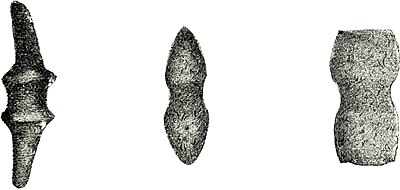The Age of the Gods.
87
forearm a dread loud-sounding elbow-pad,[1] and grasped in his hand a Heavenly vegetable-wax-tree bow and a Heavenly feathered arrow, to which he added an eight-eyed sounding-arrow.[2] Moreover he girt on his mallet-headed (II. 27.) sword,[3] and taking his place before the Heavenly Grandchild, proceeded downwards as far as the floating bridge of Heaven, which is on the two peaks of Kushibi of Takachiho in So in Hiuga. Then he stood on a level part of the floating sand-bank and passed through the desert land
of Sojishi by way of Hitawo in search of a country until he came to Cape Kasasa in Ata no Nagaya. Now at this place there was a God named Koto-katsu-kuni-katsu-Nagasa. Therefore the Heavenly Grandchild inquired of this God, saying:—'Is there a country?' He answered and said:—'There is.' Accordingly he said:—'I will yield it up to thee in obedience to thy commands.' Therefore the Heavenly Grandchild abode in that place. This Koto-katsu-kuni-katsu no Kami
- ↑ See above, p. 34.
- ↑ Or nari-kabura. Giles says they were discharged by bandits as a signal to begin an attack. "Eight-eyed" means that there were several holes in the head, the air passing through which produced a humming sound. Parker says that the nari-kabura is not Chinese, but an invention of the Huns.
- ↑ From the way in which these swords are associated with "stone-mallet" swords in the Jimmu Tennō narrative (see also Ch. K., pp. 112, 142), I am disposed to think that they were of stone, and probably identical with the mallet-shaped objects called raiko shown in Plate XI. of Kanda's "Stone Implements of Japan," from which the illustration is taken. They were, no doubt, lashed to wooden handles, and used as weapons.


